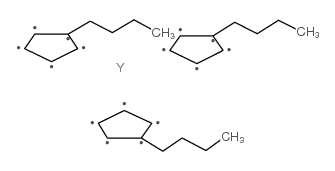312739-77-8
| Name | 2-butylcyclopenta-1,3-diene,yttrium(3+) |
|---|---|
| Synonyms |
Tris(n-butylcyclopentadienyl)yttrium(III)
Tris(p-butylcyclopentadienyl)yttrium Yttrium,tris[(1,2,3,4,5-h)-1-butyl-2,4-cyclopentadien-1-yl] MFCD00145473 |
| Density | 1.11 g/mL at 25ºC(lit.) |
|---|---|
| Molecular Formula | C27H39Y |
| Molecular Weight | 452.50400 |
| Flash Point | 135 °F |
| Exact Mass | 452.21100 |
| LogP | 7.74570 |
| Index of Refraction | n20/D 1.5685(lit.) |
|
Section 1: Product Identification Chemical Name:Tris(butylcyclopentadienyl)yttrium (99.9%-Y) (REO) CAS Registry Number:312739-77-8 Formula:(C4H9C5H4)3Y EINECS Number:none Chemical Family:metallocene Synonym:none
Section 2: Composition and Information on Ingredients IngredientCAS NumberPercentACGIH (TWA)OSHA (PEL) Title Compound312739-77-8100%1mg/m3 as Y1mg/m3 as Y Section 3: Hazards Identification Emergency Overview:Irritating to the respiratory tract, skin and eyes. May be harmful if swallowed. Primary Routes of Exposure:Ingestion, eyes, inhalation, skin Eye Contact:Causes slight to mild irritation of the eyes Skin Contact:Causes slight to mild irritation of the skin. Inhalation:Irritating to skin, eyes and respiratory tract. No specific information on the physiological effects of ingestion. Ingestion may lead to thermal burns, vomiting Ingestion: and diarrhea. Acute Health Affects:Irritating to skin, eyes and respiratory tract. Chronic Health Affects:No information available on long-term chronic effects. NTP:No IARC:No OSHA:No SECTION 4: First Aid Measures Immediately flush the eyes with copious amounts of water for at least 10-15 minutes. A victim may need Eye Exposure: assistance in keeping their eye lids open. Get immediate medical attention. Wash the affected area with water. Remove contaminated clothes if necessary. Seek medical assistance if Skin Exposure: irritation persists. Remove the victim to fresh air. Closely monitor the victim for signs of respiratory problems, such as difficulty in Inhalation: breathing, coughing, wheezing or pain. In such cases seek immediate medical assistance. Seek medical attention immediately. Keep the victim calm. Give the victim water (only if conscious). Induce Ingestion: vomiting only if directed by medical personnel. SECTION 5: Fire Fighting Measures Flash Point:not applicable Autoignition Temperature:none Explosion Limits:none Extinguishing Medium:carbon dioxide, dry powder If this product is involved in a fire, firefighters should be equipped with NIOSH approved positive pressure Special Fire Fighting Procedures: self-contained breathing apparatus and full protective clothing. Hazardous Combustion andIf involved in a fire this material may emit toxic organic fumes. Decomposion Products: Unusual Fire or Explosion Hazards: Flammable solid. Evolves flammable n-butylcyclopentadiene with water. SECTION 6: Accidental Release Measures Spill and Leak Procedures:Small spills can be mixed with vermiculite or sodium carbonate and swept up. SECTION 7: Handling and Storage Handling and Storage:Handle and store the material under an inert atmosphere of nitrogen or argon. Keep away from heat. SECTION 8: Exposure Controls and Personal Protection Eye Protection:Always wear approved safety glasses when handling a chemical substance in the laboratory. Skin Protection:Wear appropriate chemical resistant gloves and protective clothing. Ventilation:The material will react with air. Handle under an inert atmosphere of nitrogen or argon. If in form of fine dust and ventilation is not available a respirator should be worn. The use of respirators Respirator: requires a Respiratory Protection Program to be in compliance with 29 CFR 1910.134. Ventilation:The material will react with air. Handle under an inert atmosphere of nitrogen or argon. Additional Protection:No additional protection required. SECTION 9: Physical and Chemical Properties Color and Form:yellow liquid Molecular Weight:452.52 Melting Point:no data Boiling Point:no data Vapor Pressure:no data Specific Gravity:no data Odor:none Solubility in Water:insoluble SECTION 10: Stability and Reactivity Stability:air sensitive Hazardous Polymerization:no hazardous polymerization Conditions to Avoid:Contact with air or water. Incompatibility:Water, alcohols, oxidizers, oxygen, halogens, halocarbons, mineral acids. Decomposition Products:carbon monoxide, carbon dioxide, yttrium oxide and organic fumes. SECTION 11: Toxicological Information RTECS Data:No information available in the RTECS files. Carcinogenic Effects:No data available Mutagenic Effects:No data available Tetratogenic Effects:No data available SECTION 12: Ecological Information Ecological Information:No information available. SECTION 13: Disposal Considerations Disposal:Dispose of according to local, state and federal regulations. SECTION 14: Transportation Shipping Name (CFR):Non-hazardous Hazard Class (CFR):NA Additional Hazard Class (CFR):NA Packaging Group (CFR):NA UN ID Number (CFR):NA Shipping Name (IATA):Non-hazardous Hazard Class (IATA):NA Additional Hazard Class (IATA):NA Packaging Group (IATA):NA UN ID Number (IATA):NA SECTION 15: Regulatory Information TSCA:Not listed in the TSCA inventory SARA (Title 313):Title compound not listed Second Ingredient:none SECTION 16 - ADDITIONAL INFORMATION N/A |
| Symbol |

GHS02 |
|---|---|
| Signal Word | Danger |
| Hazard Statements | H226-H261 |
| Supplemental HS | Reacts violently with water. |
| Precautionary Statements | P231 + P232-P422 |
| Personal Protective Equipment | Eyeshields;Faceshields;full-face respirator (US);Gloves;multi-purpose combination respirator cartridge (US);type ABEK (EN14387) respirator filter |
| Hazard Codes | F: Flammable; |
| Risk Phrases | R17 |
| Safety Phrases | 16-36/37/39-43 |
| RIDADR | UN 3394 4.2/PG 1 |
| Packaging Group | III |
